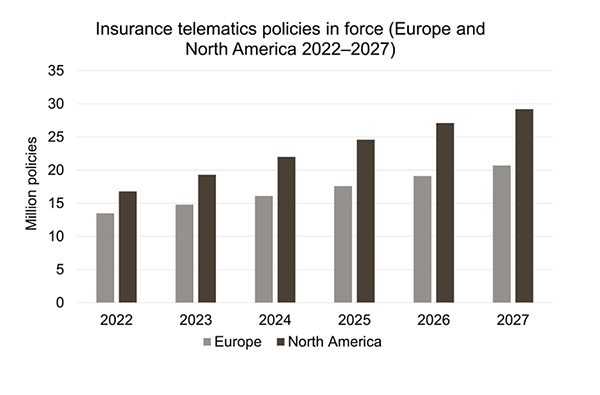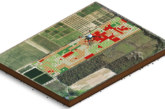
According to a new research report from the IoT analyst firm Berg Insight, the number of insurance telematics policies in force on the European market reached 13.6 million in Q4-2022.
Growing at a compound annual growth rate (CAGR) of 8.9 percent, this number is expected to reach 20.7 million by 2027. In North America, the number of insurance telematics policies in force is expected to grow at a CAGR of 11.7 percent from 16.8 million in Q4-2022 to reach 29.2 million in 2027.
The US, Italy, the UK and Canada are still the largest markets in terms of insurance telematics policies. In North America, the market is dominated by US-based Progressive, Allstate, Liberty Mutual, Nationwide and State Farm as well as Intact Financial Corporation and Desjardins in Canada. The Italian insurers UnipolSai and Generali together accounted for around 50 percent of the telematics-enabled policies in Europe. Insurers with a strong adoption in the UK moreover include Admiral Group and Direct Line.
The European insurance telematics market is largely dominated by aftermarket black boxes while mobile applications followed by self-install OBD devices represent the vast majority of the active policies in North America. Berg Insight expects continued increase in the uptake of smartphone-based solutions in all markets as well as an increase in the use of OEM telematics data in usage-based insurance programs.
The insurance telematics value chain spans multiple industries including a large ecosystem of companies extending far beyond the insurance industry players.
“Automotive OEMs like Ford, General Motors, Mercedes-Benz, Stellantis, Tesla and Toyota have all launched solutions to enable usage based insurance for their customers”, said Caspar Jansson, IoT Analyst at Berg Insight.
Connected car applications put OEMs closer to the drivers and players such as LexisNexis Risk Solutions, Verisk and CCC Information Services partner with OEMs and normalise connected car data in telematics exchanges which enables insurers to utilise telematics data from a vast range of sources as long as the policyholders agree to share their driving data.
Aftermarket telematics still plays an important role in the market for usage-based insurance. Octo Telematics has a dominant market share with more than 5.7 million devices installed in insurance telematics programs. Other end-to-end solution providers such as Vodafone Automotive, Viasat Group, Targa Telematics, IMS and The Floow are also important players on the insurance telematics market.

“Smartphone-based insurance telematics solutions are becoming a more mature solution now and we can see many insurers that start to take advantage of the concept’s potential in claims handling and as a marketing tool for example”, continued Mr Jansson.
Cambridge Mobile Telematics is a leading player in the mobile-based segment of insurance telematics and powers more than 10 million insurance telematics policies, mainly in the US. Other notable vendors of smartphone-based insurance telematics solutions include Arity (subsidiary of Allstate), Dolphin Technologies, Radius Telematics, Sentiance, OSeven Telematics, Movingdots, DriveQuant, Sycada and Telematics Technologies.
Mr. Jansson concluded:
“The uptake of smartphone-based insurance telematics policies is motivated by the low cost for implementation and insurers can also increase their customer interaction and loyalty with well-thought-out marketing and gamification features.”







